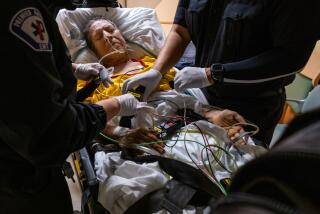Doctors could learn something about medical handoffs from the Navy
Consider the following story, from a doctor during his training: During a night on call, a patient he was “cross covering” — caring for during the night shift — went into cardiac and respiratory arrest. Dutifully, the resident and his team began to resuscitate the patient.
They performed CPR for well over a minute. Then, suddenly, they stopped — and not because the patient was beyond saving. Another team member had reviewed the patient’s chart and learned he was not a “full code.” The patient, in other words, had requested as part of his treatment plan that he not be revived should his body fail. Trying to save him had been wrong.
This mess-up — like many other errors in medicine — happened because of a botched handoff, the process by which a physician going off duty transfers responsibility of a patient to another doctor. In this case, the doctor going off duty had failed to communicate the patient’s code status to the resident taking over his care.
Handoffs are the glue that holds together a patient’s care in the hospital. Yet traditionally they have been a disorganized — even sloppy — process. During my residency, we used paper and pencil to keep track of patients and transfer their care to others. We kept these pieces of paper folded in our pockets and constantly updated them by erasing and rewriting on them.
Over the course of a day and a night on call, that pristine piece of paper got tattered and torn, confused with scribbles, eraser marks and shorthand made by many doctors. Somewhere on that paper was the right information, but it wasn’t always easy to find.
It was probably more luck than smarts that saved me from making any major mistakes through my own imperfect handoffs. Statistics show that some 80% of adverse events in hospitals involve communication problems between healthcare professionals, often in the form of a fumbled handoff. A review of surgery malpractice cases from 1991 to 2000 reported that inadequate information-sharing among team members was the primary trigger for lawsuits.
Other studies show that such lapses in communication lead to problems even when patients do not get injured or die and doctors do not get sued. Fumbled handoffs can lead to redundant tests, prolonged hospitalizations or readmissions after discharge, all of which lower the quality of care for patients and drive up healthcare costs.
To learn more about the issue, I talked to Dr. Vineet Arora, assistant director of the Internal Medicine Program at the University of Chicago Pritzker School of Medicine, who has made understanding and improving handoffs the focus of her career. She told me that handoffs have come under fresh scrutiny because of the way medicine has changed over the last decade.
There was a time in American medicine when each person had a doctor who followed him or her whether well or sick, in or out of the hospital. These days, you may see your family doctor when you are well, but if you are sick and need to be hospitalized, an expert in inpatient medicine — a hospitalist — will assume your care. And since no single hospitalist can be present around the clock, patients end up receiving care from several different ones, in shifts.
“We’ve traded familiarity and continuity for safety,” Arora told me.
The trend toward more shift changes — so that residents don’t have to work as many hours without a break, a safety move — has led to far more handoffs and, ironically, to a new set of dangers.
Experts like Arora cite a host of reasons why handoffs fail.
Some seem trivial — such as the fact that one doctor’s shorthand can mean something entirely different to another. The notation “MI,” for example, may mean “myocardial infarction” (heart attack in plain English) to one physician and “mitral insufficiency” (a condition affecting one of the valves of the heart) to another.
Frequent interruptions during the handoff process are another problem — an extremely common one. In the middle of a discussion, a doctor’s beeper may go off, or a nurse or other staff member will come over needing something right away, breaking the rhythm of discussion and the doctor’s concentration.
Hospitalists also care for large numbers of patients, many of whom have multiple, chronic, complex medical problems such as cancer, heart disease or dementia. With such patients come many drugs and much data to track — and more opportunities for a mix-up. A “typical” primary-care doctor may review up to 800 lab results, 40 radiology reports and 12 pathology reports per week. Those numbers are undoubtedly far higher for hospitalists.
There’s a cultural issue as well. Many doctors seem to view handoffs as an annoyance, even with disdain. Often, the question doctors are asking when they hand patients off isn’t “How do I get this right each time so that my patients stay safe?” but “How do I get this done so I can get out of here fast?”
The reasons go on and on, but the tough question is how to make handoffs safe and effective. In their search for solutions, many patient-safety experts are looking for answers outside of healthcare.
At Kaiser Permanente, where I practice, Doug Bonacum, vice president of Safety Management, is tasked with making handoffs work. He’s not a doctor himself — he’s a nuclear engineer and former Navy submariner. He is trying to show that the techniques he learned in the military to communicate are the exact same ones doctors need to use during handoffs.
“When I set foot on a nuclear submarine fresh out of the Naval Academy, the very first thing I had to prove was that I could use the phone,” he recalls. “That really surprised me, given that we had nuclear generators and weapons on this ship. But I wasn’t allowed to do anything more until I had shown that I could receive, and read back, an order. If I couldn’t, the officer on the line would say ‘Wrong’ and ‘Repeat again’ until I got it right.”
Bonacum shared example after example of how care of the submarine was handed off during a change of shift. “I would sign out the issues and events that happened on my watch the same way each day,” he says. “Anybody who assumed my post would do it the exact same way to their relief as well. In medicine, if I follow three different doctors around on three different days, I’ll see three different ways of signing out patients.”
Doctors are also learning from aviation, where critical processes are handled using checklists. Checklists have already improved patient safety in intensive care units and operating rooms. Some centers have created handoff checklists too to ensure crucial items (such as a patient’s code status) are never missed.
But there’s more to be learned from the field. Another aviation technique — the “sterile cockpit” — requires that pilots refrain from nonessential activities during certain points during flight. It’s designed to limit interruptions when the crew talks about critical issues related to the flight. In medicine, that would mean setting aside a quiet place for handoffs that are buffered from beepers, phones and other distractions.
We doctors could also learn a lot by just looking over our shoulder at nurses. Anybody trying to talk to a nurse during a shift change, be it a doctor, a family member or a patient, gets mildly reprimanded. Nurses are simply off-limits while they’re handing off patients. At Kaiser, nurses have adopted another innovative technique: signing off at a patient’s bedside so that patients and family members will hear the plan and have an opportunity to ask questions or correct something if it does not sound right.
Bonacum and Arora say they see generational differences in doctors’ willingness to embrace better handoff techniques, which is a hopeful sign. Residents, who are increasingly required to have formal training in handoffs, are fast adopting new techniques. They seem to have the perspective that teams of people working together keep patients safe.
Yet for more seasoned doctors, there’s inertia. Many consider advice or a mandate to do things one way every time — be it a handoff or something else, like using a checklist — as an insult to their intelligence and authority.
The sad thing is, they often feel a deep sense of personal responsibility for their patients, which leads them to blame themselves when things go wrong. Yet the very systems they bristle against could well prevent those errors to begin with.
Parikh is a physician and writer in the San Francisco Bay Area. He writes PopRx, a weekly column about medicine and culture, for Salon.com.
https://www.rahulkparikh.com
https://www.twitter.com/docrkp






